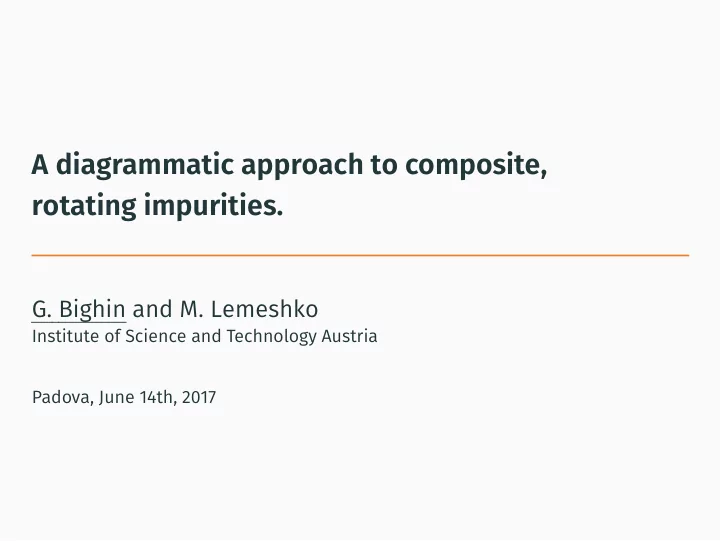

A diagrammatic approach to composite, rotating impurities. G. Bighin and M. Lemeshko Institute of Science and Technology Austria Padova, June 14th, 2017
Summary • Introduction: impurity problems • The angulon quasiparticle • A path integral/diagrammatic approach to the angulon • The angulon spectrum • Dynamics 2/26
Impurity problems Definition: one (or a few particles) interacting with a many-body environment. How are the properties of the particle modified by the interaction? degrees of freedom. • Condensed matter (electrons in solids) • Chemistry (molecules in a solution) • Ultracold atoms (atomic impurities in a BEC) 3/26 ( 10 23 ) Still O
Quasiparticles Quasiparticles provide a trick to understand what happens in a complex system. Bare particle + field of many body excitations Picture from Richard D. Mattuck, “A Guide to Feynman Diagrams in the Many-Body Problem” . 4/26
From impurities to quasiparticles Structureless impurity: translational degrees of freedom/linear momentum exchange with the bath. Most common cases: electron in a solid, atomic impurities in a BEC. Image from: F. Chevy, Physics 9 , 86. Composite impurity: translational and internal (i.e. rotational) degrees of freedom/linear and angular momentum exchange. 5/26
From impurities to quasiparticles Structureless impurity: translational degrees of freedom/linear momentum exchange with the bath. solid, atomic impurities in a BEC. Image from: F. Chevy, Physics 9 , 86. Composite impurity: translational and internal (i.e. rotational) degrees of freedom/linear and angular momentum exchange. 5/26 Most common cases: electron in a
From impurities to quasiparticles Structureless impurity: translational degrees of freedom/linear momentum exchange with the bath. Most common cases: electron in a Image from: F. Chevy, Physics 9 , 86. Composite impurity: translational and internal (i.e. rotational) degrees of freedom/linear and angular momentum exchange. 5/26 solid, atomic impurities in a BEC.
From impurities to quasiparticles Structureless impurity: translational degrees of freedom/linear momentum exchange with the bath. Most common cases: electron in a Image from: F. Chevy, Physics 9 , 86. Composite impurity: translational and internal (i.e. rotational) degrees of freedom/linear and angular momentum exchange. 5/26 This scenario can be formalized using the polaron. solid, atomic impurities in a BEC.
From impurities to quasiparticles Structureless impurity: translational What about a rotating particle? Can there polaron. This scenario can be formalized using the 5/26 exchange. freedom/linear and angular momentum internal (i.e. rotational) degrees of Composite impurity: translational and Image from: F. Chevy, Physics 9 , 86. Most common cases: electron in a momentum exchange with the bath. degrees of freedom/linear bra describing rotations. solid, atomic impurities in a BEC. be a rotating analogue of the polaron? The main difficulty: the non-Abelian SO(3) alge-
The angulon phonons 4 Y. Shchadilova, ”Viewpoint: A New Angle on Quantum Impurities” , Physics 10 , 20 (2017). 3 M. Lemeshko, Phys. Rev. Lett. 118 , 095301 (2017). 2 R. Schmidt and M. Lemeshko, Phys. Rev. X 6 , 011012 (2016). 1 R. Schmidt and M. Lemeshko, Phys. Rev. Lett. 114 , 203001 (2015). bath 3 . molecule in any kind of bosonic • Phenomenological model for a in a weakly-interacting BEC 1 . • Derived rigorously for a molecule • Linear molecule. molecule-phonon interaction A composite impurity in a bosonic environment can be described by the 6/26 J 2 molecule angulon Hamiltonian 1 , 2 , 3 , 4 (angular momentum basis: k → { k , λ, µ } ): [ ] ∑ ∑ ω k ˆ k λµ ˆ φ )ˆ φ )ˆ ˆ B ˆ b † λµ (ˆ θ, ˆ b † k λµ + Y λµ (ˆ θ, ˆ Y ∗ H = + + U λ ( k ) b k λµ b k λµ ���� k λµ k λµ � �� � � �� �
• Ultracold molecules and from the electrons to a Composite impurities and where to find them • Electronic excitations in Chem. Int. Ed. 43 , 2622 (2004). Image from: J. P. Toennies and A. F. Vilesov, Angew. crystal lattice. • Angular momentum transfer Rydberg atoms. ions. Strong motivation for the theoretical study of composite impurities renormalization). rotational constant (rotational spectra, helium nanodroplets comes from many different fields. Composite impurities are realized as: 7/26 • Molecules embedded into
• Ultracold molecules and from the electrons to a Composite impurities and where to find them Strong motivation for the theoretical study of composite impurities Chem. Int. Ed. 43 , 2622 (2004). Image from: J. P. Toennies and A. F. Vilesov, Angew. phase Gas crystal lattice. • Angular momentum transfer Rydberg atoms. • Electronic excitations in ions. renormalization). rotational constant (rotational spectra, helium nanodroplets comes from many different fields. Composite impurities are realized as: 7/26 • Molecules embedded into in 4 He in 3 He
• Ultracold molecules and from the electrons to a crystal lattice. fective B ) lines (smaller ef- Renormalizated trum Rotational spec- Chem. Int. Ed. 43 , 2622 (2004). Image from: J. P. Toennies and A. F. Vilesov, Angew. phase Gas Composite impurities and where to find them Strong motivation for the theoretical study of composite impurities • Angular momentum transfer Rydberg atoms. • Electronic excitations in ions. renormalization). rotational constant (rotational spectra, helium nanodroplets comes from many different fields. Composite impurities are realized as: 7/26 • Molecules embedded into in 4 He in 3 He
Recommend
More recommend